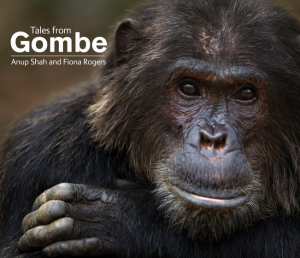Book Review: Tales from Gombe

Tales from Gombe is an intimately illustrated coffee table book created by wildlife photographers Anup Shah and Fiona Rogers. It details the simian soap operas and political scandals occurring amongst a community of wild chimpanzees in the Gombe Stream National Park, a fragile habitat on the shores of Lake Tanganyika in Tanzania.
From a photographic perspective, the book offers many up-close and personal portraits of the main movers and shakers of this chimpanzee world, made famous by the pioneering work of Jane Goodall. If you’re looking for awe-inspiring pictures of landscapes and other wildlife, or even amazing action shots of the chimps, you will, however, be disappointed. There is nothing here that compares with the work of Ansel Adams or Nick Brandt, or even many of the original chimpanzee action shots by Hugo van Lawick. And that’s okay because the portraits are quite compelling as illustrations of the very essence of evolution. Indeed, it’s impossible to look at these portraits, focus on the chimps’ eyes, and not recognize that very little separates us from them and that we have a shared, distant past.
Those looking for a scholarly examination or a scientifically accurate discussion of chimpanzee society will also be disappointed. For clear explanations and emotive writing, the original National Geographic articles or the various books by Goodall are still head and shoulders above this. Here, Shah and Rogers provide extended commentary that is at times too convoluted and confusing, with too many characters doing too many things on the same page. So, for example, opposite an engaging picture of a young chimp named Gimli reclining on a log, is this:
Previously Gimli had been playing with Google and the game had got quite rough. Gaia vocalized to stop Gimli playing, which he did. After a while, a bored Gimli went to Google to play again, but Gaia stopped him. Gimli looked at Gremlin who assented with Gaia. Gimli at once threw a tantrum. Gizmo got frightened and went to Gaia who was already clutching Google, and she put her arms around both of them. Once his tantrum was over, Gimli apologized to Gremlin by touching her with an outstretched arm.
And next to another thoughtful portrait of Gimli, the reader is given this to sort through:
He often regarded himself to be the big man in the G family. Once, Fanni was sitting with Fifty when she was approached by Golden with an outstretched hand and Glamour readying herself to play with Fifty. Glitter, with baby Gossamer, was following Golden. Inexplicably, Fanni displayed at the twins, sending them up a tree. Eight-year-old Gimli, who was sitting with Gremlin, saw this from afar and came bounding over. With considerable officiousness, he shepherded the twins safely to Gremlin, not that they needed Gimli’s help.
Shah and Rogers’ chronicles desperately needed a fine-tooth editorial comb run through them in order to avoid confusion.
While there is a real need for us to use more anthropomorphic and emotive language if we are ever to grasp the minds and lives of nonhuman primates, especially chimpanzees and other great apes, Tales from Gombe often goes a bit too far. It’s very obvious from the intensity of some of the portraits that the chimps meant a lot to the photographers, but there is a distinction between useful reportage and the festive letters proud parents send out detailing the exploits of their children, which I was often reminded of when reading many of the stories herein. Describing the unexpected death of their favorite chimp, Freud, for example, they say he died “at one of his favorite spots…apparently peacefully and in a gentlemanly style.” I have no idea what this sentence means; how does any being die in “gentlemanly” style?
There will always be room for another book about these awe-inspiring, almost-human beings. If Tales from Gombe inspires us to learn more about and respect our closest cousins (and other primates) and get actively involved in protecting their environments—which it may very well do—then this book will be more than worth the price paid for it. While I had the privilege, decades ago, to spend a year at Gombe, for others, this book may be the best alternative way to get there.
